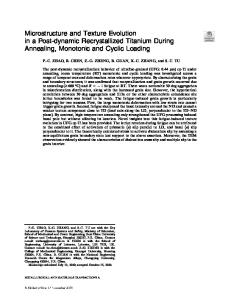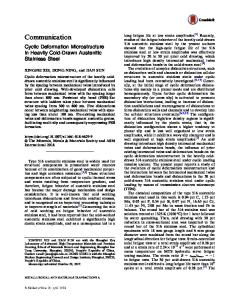Microstructure evolution in monocrystalline silicon in cyclic microindentations
- PDF / 256,128 Bytes
- 4 Pages / 612 x 792 pts (letter) Page_size
- 49 Downloads / 345 Views
M.V. Swain School of Aerospace, Mechanical and Mechatronic Engineering, Biomaterials Science Research Unit, The University of Sydney, Eveleigh, New South Wales 1430, Australia (Received 11 December 2002; accepted 17 January 2002)
The study presents evidence of the microstructural evolution during cyclic indentation of monocrystalline silicon with a spherical indenter. Transmission electron microscopy examination of microindentation on cross-section view samples showed that the structure change in the transformation zone features a decomposition of the amorphous phase to R8/BC8 crystals. Outside the zone, cyclic loading gives rise to bending of pristine silicon, slip penetration, and radial cracking. The development of the load–displacement curves during consecutive indentations is justified in terms of the phase transformation events observed.
Indentation has been used extensively to investigate the behavior of monocrystalline silicon,1–14 as it permits insight into the plastic deformation and surface machining mechanisms of this inherently brittle material. It has been shown that the behavior of silicon in the first indentation cycle is characterized by multiple phase transformations, leading to a substantial hysteresis of the load–displacement curves.6,11,15 Upon loading, the initial diamond structure of silicon changes to a metallic tetragonal –Sn phase, bringing about the first phase transformation. 7 On unloading, the –Sn converts to amorphous or crystalline R8/BC8 phases, depending on the maximum indentation load Pmax and the loading/ unloading rate.5,11,14,15 A lower Pmax and fast unloading rate would promote the amorphous phase change, but a higher Pmax and slower unloading rate would initiate the transformation to the metastable R8/BC8 phases.11,15,16 A unique behavior of silicon was identified in multiple indentations with a Berkovich indenter.9,10 The load– displacement curve showed nondegenerative hysteresis under low indentation loads. When the load was high, however, the hysteresis disappeared in the second cycle as a result of cracking in the subsurface. It was suggested that the indentation with a Berkovich indenter produces amorphous transformation and results in a nondegenerative hysteresis.17 Nevertheless, the hysteresis would disappear when the R8/BC8 phases emerged. It was reported that silicon behaves differently under cyclic indentations with a spherical indenter.18 It was shown that the transformed structure developed in the first indentation cycle was unstable and could be altered by a number of indentation variables, such as the maximum 758
http://journals.cambridge.org
J. Mater. Res., Vol. 18, No. 4, Apr 2003 Downloaded: 18 Mar 2015
indentation load Pmax. However, the details of the structural evolution corresponding to the cyclic indentations were unclear. The present study aims to clarify the mechanisms. The test material was a monocrystalline silicon (100) wafer. The spherical indenter used had a nominal radius of 5m. The indentation tests were conducted on an Ultra-Micro Inden
Data Loading...






